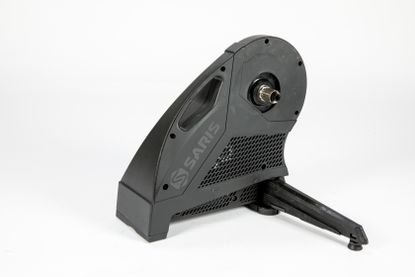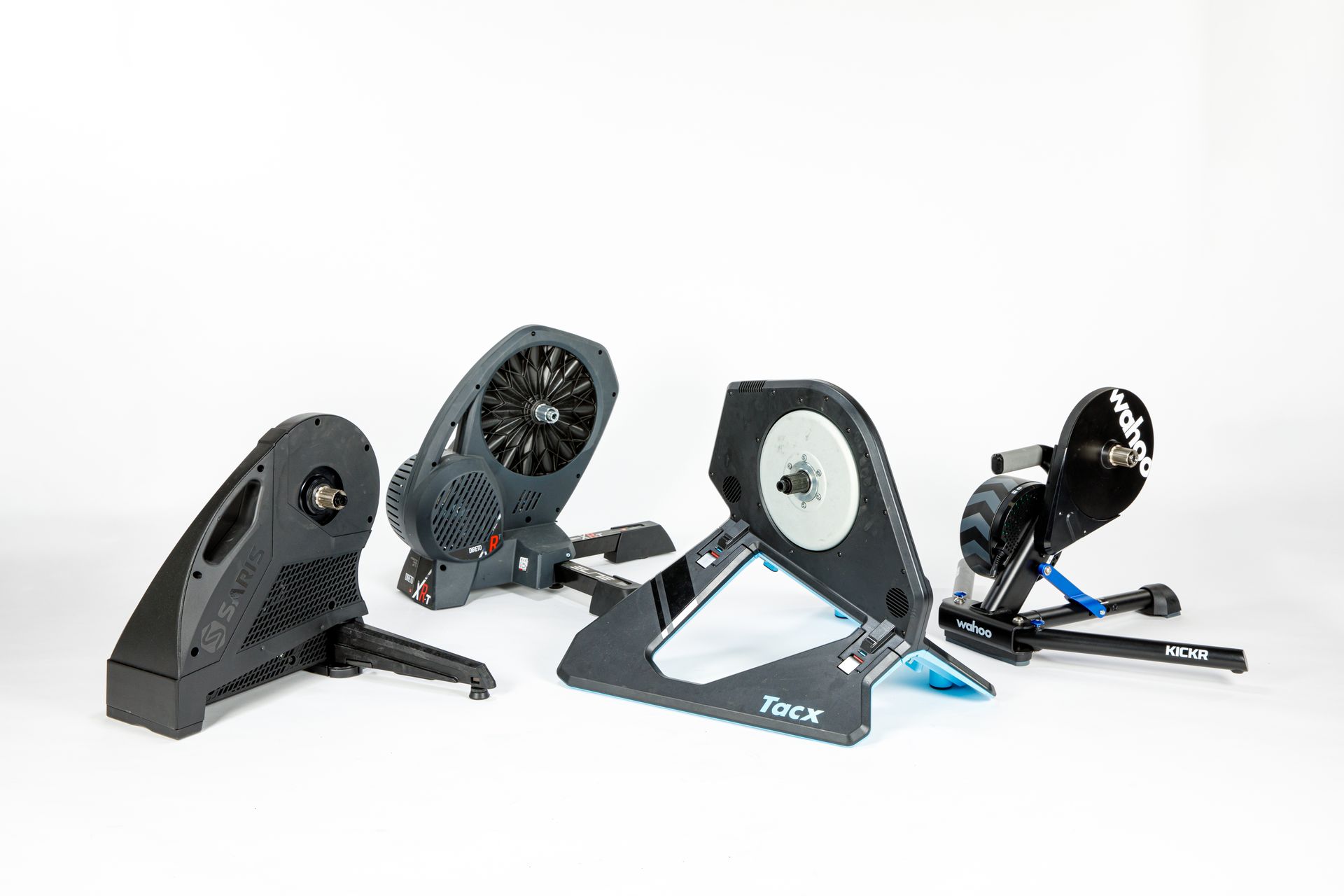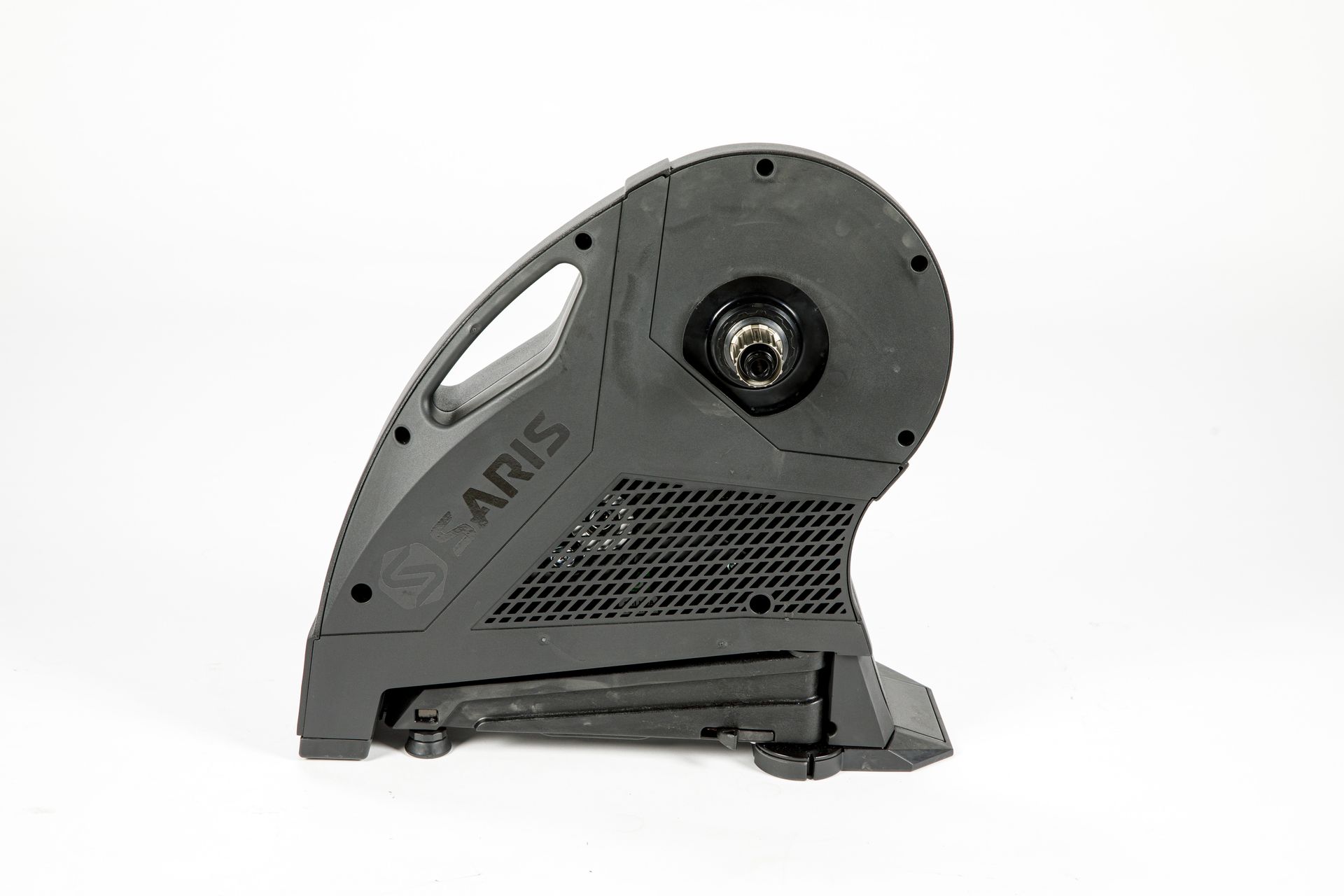Saris H3 Smart Trainer review
A straightforward performance turbo without gimmicks

Unlike other brands which are constantly packing in ever more features – including ones you may not ever use – Saris has opted to keep the H3 free from gimmicks, which also makes it a little cheaper. The H3 still does everything you really need from a turbo and has a high maximum resistance and simulated gradient as well as power accuracy sufficient for the top tier Zwift races. However, it does have some drawbacks in its need to be manually calibrated, its unfriendliness to certain thru-axles and the fact that our unit gave notably high power readings.
- +
Very sturdy platform for sprints and hard efforts
- +
No novelty features means a lower price
- +
- -
The body shape doesn't play nicely with thru axle handles
- -
Needs to be manually calibrated
- -
Our test unit gave notably high power readings
You can trust Cycling Weekly.Our team of experts put in hard miles testing cycling tech and will always share honest, unbiased advice to help you choose.Find out more about how we test.

Saris is a brand which likes to keep things simple. Where some manufacturers spin out a dizzying array of different models, the American brand only offers one direct drive option – the H3.
This inclination for minimalism extends to the features offered – while others are adding the ability to simulate cobbles, raise the front end to better simulate climbs and integrate virtual steering, the H3 instead keeps things simple
If you think of those features as gimmicks, then really, why should you pay more for the pleasure of having them?
We tested the Saris H3 as part of a four-up comparison grouptest to find thebest smart turbo trainer, the Saris H3 went up alongside the Elite Direto XR-T, the Wahoo Kickr V5 and Tacx Neo 2T.

L-R: Saris H3, Elite Direto XR-T, Tacx Neo 2T, Wahoo Kickr V5
The specs

The big three features that brands most love to shout about are: the maximum possible resistance, the maximum simulated gradient and the accuracy of thepower meter.
Coming in with a maximum resistance and gradient of 2,000w and 20%, respectively, and a claimed accuracy of ±2%, the H3 unfortunately does lose the game of spec-sheet top-trumps to most of its competition.
But with that said, it is worth actually considering how these numbers would relate to your use, rather than simply opting for the ethos of ‘more equals better’.
2,000w is the kind of power top-level track sprinters put out, it is very unlikely you would need anything more than this. In terms of the maximum gradient, the steepest climb we’ve come across on Zwift is indeed a little more than the H3 can simulate at 22% – but it’s only for a second or two though, so you aren’t really going to miss it.
(In case you’re wondering, that’s on the second climb of the ‘Cobbled Climbs Reverse’ course in the Richmond world).
Now, as it happens, we do have some concerns about the power numbers of the H3 (read on for that), but it is worth noting that a claimed accuracy of ±1% is hardly a silver bullet. We have also tested power meters against each other which both claim accuracy of ±1% but have still ended up falling outside of each others’ ranges. An accuracy of ±2% is still regarded as sufficiently accurate for racing in the very top level of Zwift races.
Compatibility and setup

Regarding axle and freehub compatibility, Saris isn’t as comprehensive as the likes of Tacx or Elite. The trainer is compatible with QR widths of 130mm and 135mm, as well as with thru axles which measure 142x12mm or 148x12mm.
But this does mean if you’re planning on using a modern mountain bike with 148x12mm thru axles or those early road standards of 135x10mm, 135x12mm or the lesser spotted 141mm QR, then you’re out of luck.
The turbo ships with a standard Shimano/SRAM 8–11 speed freehub (which is still compatible with new 12 speed Ultegra and Dura-Ace), while a SRAM XD/XDR freehub is available separately.
If you’re running a Campagonologroupsetor want to use a Shimano 12-speed mountain bike cassette requiring a Microspline freehub then, again, you’re out of luck.
Setting up the turbo is a breeze. Straight out of the box, all you need to do is pop on a cassette and flick out the legs – which conveniently also store the riser plate for the front wheel. The H3 is very heavy and the handle doesn’t make carrying it around super easy, but it is still among the more mobile of trainers – and the foldaway size is quite reasonable.
We're continuing to see more turbos on the market which automatically zero offset / 'calibrate' themselves – but the H3 isn't one of them. To ensure you're getting accurate readings, you'll need to warm up the turbo by riding for 10 mins and then perform a quick spin down test.
The ride

现在,我还没有遇到一个直接驱动涡轮trainer which won’t move about when I’m sprinting – even the 50kg Tacx Neo Bike Smart doesn’t stay completely rock-solidly in place. But even so, the weight and wide footprint of the Saris H3 meant that it does rank among the most stable turbos I’ve used.
结束的感觉good sprint感觉很棒。一些涡轮发动机领域寻求模仿户外riding as closely as possible, with a high amount of resistance at the start, with that dropping off as you spin up to speed – requiring a large number of gear shifts to keep the perceived resistance the same.
The H3, on the other hand, feels much more linear and requires fewer gear shifts – this may not be so realistic, but it's a better experience on the turbo.
Coming now to the erg mode, I got on pretty well with the way the H3 would keep me at a constant wattage, as it increased the resistance when my cadence dropped and decreased it when my cadence climbed too high. Some other turbos can have a tendency of quickly sending you into something of a death spiral of ever increasing resistance if you let your legs slow too much, but that wasn’t an issue here.
When doing some short 30s on / 30s easy intervals, the ramping up of the resistance to 400w felt a good balance, it didn’t take ages and feel like it was dragging out, but equally it didn’t feel like I was hitting a brick wall.
Power analysis
I used the turbo trainer's erg mode to compare power. I set the turbo to have me ride at 250w, for 10 minutes, then compared the numbers to aShimano Dura-Ace power crankandGarmin Vector pedals(the updated model which fixed the early issues). The erg mode won't hold at exactly 250w due to changes in cadence, but it's close. The result was:
| Saris H3 turbo trainer | 249w |
| Shimano Dura-Ace power cranks | 237w |
| Garmin Vector 3 power pedals | 238w |
So the H3 did read significantly higher than both the other power meters – and as those pedals and cranks have lined up pretty closely with other power meters, I’d be inclined to go with their numbers. This is just a sample size of one, so other H3 turbos may line up better, but it is still an unfavourable data point, though.
I also did five 30s on / 30s easy to see how the numbers lined up for higher intensity efforts, and again, although the Saris H3 was very close to what the erg mode was set to in the numbers it read out, they were still significantly higher than what the Dura-Ace crank or the Vector pedals reported.
| Row 0 - Cell 0 | Effort 1 | Effort 2 | Effort 3 | Effort 4 | Effort 5 |
| Saris H3 turbo trainer | 398w | 398w | 396w | 397w | 394w |
| Shimano Dura-Ace power cranks | 370w | 375w | 381w | 391w | 387w |
| Garmin Vector 3 power pedals | 368w | 367w | 373w | 383w | 385w |
The same pattern continued for the sprint efforts, with the Saris still reading higher than the other power meters.
| Row 0 - Cell 0 | 1 sec | 5 sec |
| Saris H3 turbo trainer | 1,200w | 1,147w |
| Shimano Dura-Ace power cranks | 1,130w | 1.082w |
| Garmin Vector 3 power pedals | 1,141w | 1,061w |
Finally, doing 10s on / 10s completely off, I found that the Saris H3 would drop to zero at almost exactly the same time as the Dura-Ace power crank, generally just a couple of seconds slower than the Vector pedals.
But a second or so after that, I'd get consistently get a surprise 10w spike before dropping again to zero. Not an issue if you're just doing training plans on the turbo, but a little infuriating when trying to quickly assume a 'super tuck' position while going downhill in a Zwift race.
Value

At $1,099.99 / £899.99, the Saris H3 does undercut Wahoo and Tacx’s offerings ($1,199.99 / £999.99 and $1,399.99 / £1,199.00, respectively), although it is a little more expensive than the Elite Direto XR-T at $949.99 / £829.99.
Compared to the Elite Direto XR-T, the Saris H3 has a more stable platform for sprinting, the erg mode feels better and the turbo drops to zero watts quicker. The only real points against it are that in our test the H3 read power significantly high, whereas the Direto XR-T was much more in line with the power cranks and pedals. For the $155 / £70 price difference, we think the Saris is the better buy.
它是如此a shame about the H3’s need to be manually calibrated, the 10 watt blip when stopping pedalling, our unit’s high power readings, and thru axle issue. If it wasn’t for these points, it would be great to have a competitor undercutting Wahoo or Tacx’s offerings, without the novelties of a raised front end or a simulated cobble effect.
But with those issues, unless you are on a really strict budget, we would recommend going for the Kickr or Neo 2T and doing away with those irritants – the turbo isn’t so much cheaper that it can really justify their presence.
Conclusion
The Saris H3 is a straightforward, no frills turbo which provides a really solid platform for sprinting and a well balanced erg mode.
Unfortunately, it does have a few drawbacks over the competition from Wahoo and Tacx, such as the need to manually calibrate, a 10 watt blip when stopping pedalling, a body design that’s not so friendly to thru axles with handles the fact our unit had notably high power readings.
It is still a very good turbo, and if you are on a strict budget, we would happily recommend it. But if your bank balance could stretch to the Kickr, it would be worth the extra $100 / £100.

Thank you for reading 10 articles this month* Join now for unlimited access
Enjoy your first month for just £1 / $1 / €1
*Read 5 free articles per month without a subscription

Join now for unlimited access
Try first month for just£1 / $1 / €1

After winning the 2019 National Single-Speed Cross-Country Mountain Biking Championships and claiming the plushie unicorn (true story), Stefan swapped the flat-bars for drop-bars and has never looked back.
Since then, he’searnt his 2ⁿᵈ cat racing licence in his first season racing as a third,completed the South Downs Double in under 20 hoursandEverested in under 12.
But his favourite rides are multiday bikepacking trips, with all the huge amount of cycling tech and long days spent exploring new roads and trails - as well as histories and cultures. Most recently, he’s spenttwo weeks riding from Budapest into the mountains of Slovakia.
Height: 177cm
Weight: 67–69kg
-
 Glasgow World Championships threatened with disruption from strikes
Glasgow World Championships threatened with disruption from strikesGMB union in the midst of a pay dispute with local councils
By Vern Pitt •Published
-
 USA Pro Nationals: Dygert, Labecki, McNulty, Barta to battle for the Stars and Stripes jersey in Tennessee
USA Pro Nationals: Dygert, Labecki, McNulty, Barta to battle for the Stars and Stripes jersey in TennesseeFor a sixth year in a row, the U.S. Pro Nationals returns to Knoxville, Tennessee, to see the best riders in the county compete for the coveted Stars and Stripes jersey.
By Henry Lord •Published
-
 4 dead after New York e-bike shop catches fire
4 dead after New York e-bike shop catches fireNew York City has already seen more than 100 fires and 13 deaths linked to lithium-ion batteries in 2023
By Anne-Marije Rook •Published


